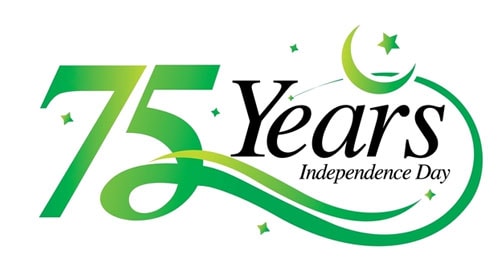A Diamond Jubilee Round-Up: 1947 – 2022
The Islamic Republic of Pakistan celebrates today 75 complete rounds around the sun. A country built with sweat and tears, relentless hard work, and effort, and an unmatched vision stands tall and proud as the first and only Muslim nuclear state with the sixth largest army in the world. Beyond the military might, the nation has bagged achievements including being home to the youngest Nobel Laureate, effectively running the world’s largest volunteer ambulance service, and being responsible for producing over half the world’s footballs. The country has also given the world stars like the unbeatable Jehangir khan to the self-trained Javelin thrower Arshad Nadeem from the small town of Khanewal, reflecting potential and talent in all its stretch. From K2 to the world’s largest deep sea port, Gwadar, to the world’s highest paved road, the Karakoram Highway, Pakistan is diverse in its people, geography, culture, and existence. Winning the Cricket World Cup in 92, exploding five nuclear devices in 98, and experiencing an economic boom from the years 2003 to 08, the relatively young country has seen many highs in the last 75 years of its rocky existence.

While the introduction paints a rosy image of what the country has looked like historically, the flipside reality is equally important and real. Without taking away from the long list of achievements, a reflection of why the country has failed to tap into its full potential is critical to reflect upon as we once again embark on celebrating our freedom with the green and white loud and proud on our chests. A look back at history suggests that both our major independence anniversaries have seen the country in or on the brink of a significant crisis. The Islamic Republics’ silver jubilee saw the nation recovering from the terrors of the infamous 1971 war that led to the creation of what was then East Pakistan and today Bangladesh. When the war ended on 16th December 1971, a towering 93,000 Pakistani soldiers surrendered to the Indian Armed Forces, the country lost over half of its population and close to 15 percent of its geographical territory. When the country celebrated its 50th birthday 25 years later in 1997, it was close to diving into the nuclear world the following year. Now, in 2022, when 75 years of independence and freedom are being celebrated, the country once again finds itself entangled in a hard-hitting economic crisis coupled with political instability and threatened institutions. Fuel prices are conversing with the sky and the rupee against the dollar is nothing short of a joke. 75 years later, the country is in shackles, close to rock bottom; a statement that is neither exaggerated nor untrue.
The Islamic Republic of Pakistan, a state created with endless hopes and dreams for millions of people finds itself in the deep end upon its diamond jubilee. This situation, in comparison to India, a country also celebrating its 75 years tomorrow and a country that we broke from, and in comparison to Bangladesh, which celebrated 51 years of independence earlier this year and a country that broke from us is very different. Both reflect better in every aspect, which ultimately raises the question(s): why two countries similar to us are outperforming us? Why are we unable to reach the same heights and why if all three come from the same line of history and thereby the same fundamentals have developed so differently?
The list is long but a wide range of pre and post-partition factors aid the explanation of our varying paths from our cultural twins. When sifting historical books a recurrent theme that pops up is the idea of national cohesion enabling national growth. Cohesion can take the shape of a nation bundled together under the umbrella of religion, ethnicity, race, and/or values. Simultaneously cohesion can also take the shape of different groups living together under a national banner where the agreement may not be on religious beliefs or cultural values but on the shared benefits of living together. When shedding light on the cohesive Republic of India, diversity comes to mind whereas the opposite i.e homogeneity is what one thinks of when looking at Bangladesh. Examining Pakistan’s national cohesion, the structure appears to be similar to that of Bangladesh – a country deeply solidified under the banner of Islam. However, scratching the surface just a little brings forth the reality that even a common Muslim identity, which should’ve acted as the glue for the nation, is fragmented by large chunks of ethnic and sectarian divides creating a country that time and again faces instability rooted in these very divides. Dr. Niaz Murtaza in his article titled ‘The Nation at 75’ rightfully points out another pre-partition factor that set neighboring India and eastwards Bangladesh at an unequal footing with Pakistan regardless of the many aforementioned similarities. This being the uneven capacities of the “three mother national institutions” also referred to as the parties that struggled for freedom. Although Congress and Muslim League existed in India long before the 1947 partition and so did the Awami league before 1971 in the then East Pakistan, the Muslim League faced a heavier brunt of instilling the idea of nationhood in the newly formed Pakistan. The juxtaposition is such that the freedom parties in both India and Bangladesh were socially entrenched to a greater extent. In the newly formed Islamic Republic, the hearsay was that a nation built in the name of religion required no “cultivation”. These major political shortcomings for the Muslim League in Pakistan proved to have consequences for the state to this very day. These factors at birth and post-partition issues have set our beloved nation apart from our counterparts and our cultural offspring.
When looking at the decades post-partition, there has not been one that is not responsible for the current state of affairs of this nation. However, it was particularly under the reign of General Zia Ul Haq that the narrative and thereby full execution of the ‘state geopolitical development model’ came into play the most. The centralization of power not in line with the fundamentals of a democratic country developed and persisted with a security-focused outlook that survived heavily on aid from the big brothers around the globe. It should come as no surprise that the power aid was then divided among the few at the top in different ways including subsidies. Therefore it would not be wrong to say that it was this era that was the brainchild behind producing an economy dependent on the aid of all sorts and not self-suffiecny of any. During the same era, the extremist groups were well-fed to carry forward region-specific and nation-specific goals against enemies from within and abroad. As the years have gone by, the global landscape has changed. The foundations on which stood the Zia-era model is today highly controversial and damaging to the country and its foreign presence. The world, now more sensitive than ever before, is not, anymore, welcoming extremist groups with open arms. The brunt of that era is faced to even this day when political engineering and extremist and populist politics is the order of the day. It would also be stating the obvious that such a model has produced a failing economy and a worrying state of affairs. The irony of, mind you, the Islamic Republic of Pakistan, is that while the model in place is clearly failing, a new replacement model that is democratic and not just for the elite is not attractive to those in power.
While the blame does rightfully lie with the elite and those in power, it does not shy away from those from the middle class and the lower middle class. Therefore, if Pakistan is to progress, succeed and grow in the next 75 years, a top to bottom reform is required. While the thought is exceptionally hopeful, the country has, every few years proved its resilience and potential and therefore makes each Pakistani say ‘Pakistan Zindabad’ a little louder and prouder every passing year.










